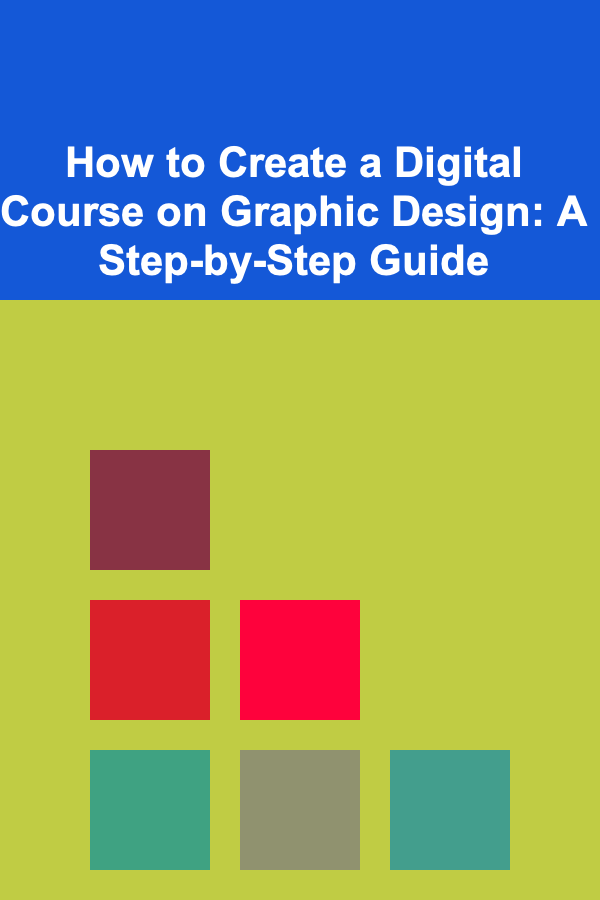
How to Create a Digital Course on Graphic Design: A Step-by-Step Guide
ebook include PDF & Audio bundle (Micro Guide)
$12.99$8.99
Limited Time Offer! Order within the next:

Creating a digital course on graphic design is an exciting opportunity to share your knowledge, inspire creativity, and help others build valuable skills. Whether you're a professional graphic designer, an educator, or simply passionate about design, building an online course can be a highly rewarding venture. This actionable guide will take you through the entire process of creating a high-quality, engaging digital course on graphic design---from ideation to marketing and selling.
Step 1: Define the Course Goals and Audience
1.1 Establish Clear Learning Objectives
Before you dive into the content creation process, it's essential to define clear learning goals for your course. These objectives will guide the structure and delivery of your lessons and help students know what to expect. For a graphic design course, some potential objectives could include:
- Understanding the principles of design (balance, contrast, emphasis, etc.)
- Gaining proficiency in popular design tools like Adobe Photoshop, Illustrator, or Figma
- Learning how to create and manipulate vector graphics
- Developing skills in branding, typography, and color theory
- Building a professional portfolio for future job opportunities
Your course's success hinges on clearly communicating what students will be able to achieve by the end of it. Make sure your objectives are actionable and specific.
1.2 Identify Your Target Audience
Once you've set your learning objectives, the next step is identifying your target audience. Who will benefit most from your course? Your target audience could include:
- Beginner designers: People with little to no design experience who are looking to learn the fundamentals of graphic design.
- Intermediate designers: Those who have basic design knowledge and want to deepen their skills or learn new tools and techniques.
- Entrepreneurs: Small business owners or marketers who need graphic design skills to create logos, websites, and marketing materials.
- Design students: Those currently studying design and looking for additional resources to supplement their learning.
Understanding your target audience's needs, skill levels, and goals will allow you to tailor your content accordingly.
Step 2: Plan the Course Structure and Content
2.1 Break Down the Content Into Modules
Organizing your course content into digestible modules is crucial for both learner engagement and the overall flow of the course. Each module should cover a specific topic or set of related skills.
For example:
-
Module 1: Introduction to Graphic Design
Topics: Design principles, history of graphic design, and overview of essential tools.
-
Module 2: Mastering Adobe Photoshop
Topics: Interface overview, basic tools, working with layers, masks, and brushes.
-
Module 3: Typography and Color Theory
Topics: Font pairing, creating effective typography, understanding color psychology.
-
Module 4: Logo Design and Branding
Topics: Creating logos, brand identity, and applying design principles to branding.
-
Module 5: Building a Portfolio and Freelancing Tips
Topics: Portfolio design, how to showcase work, pricing for freelancers.
By breaking your course into modules, you'll make it easier for students to track their progress and stay engaged. Each module can contain several lessons with actionable steps.
2.2 Create Lesson Plans and Resources
Once you have your course structure, it's time to develop individual lessons. Each lesson should include:
- Introduction: A brief overview of what will be covered.
- Theory: The principles or concepts that are central to the lesson.
- Practical Application: Real-world examples, case studies, and exercises where students can apply what they've learned.
- Assignments: Hands-on tasks that challenge students to create something based on the lesson's content. This can include designing logos, posters, or websites.
- Conclusion: A summary of key takeaways from the lesson.
Additionally, you can provide supplementary materials like:
- Downloadable assets: Design templates, cheat sheets, and sample files for students to use in practice.
- Quizzes: Short quizzes or assessments to test students' understanding of the material.
Including a mix of theoretical and practical elements will cater to different learning styles and ensure that students can immediately apply their newfound skills.
Step 3: Choose the Right Platform
3.1 Select a Course Hosting Platform
Choosing the right platform to host and sell your course is crucial for providing a seamless experience for your students. There are several options to choose from, depending on your needs and technical expertise:
- Teachable: A user-friendly platform designed for online courses. It allows you to create a course, upload videos, set pricing, and manage students---all from one platform.
- Udemy: A large marketplace for online courses. Udemy is ideal if you want to tap into an existing audience but will take a percentage of your course sales.
- Skillshare: Similar to Udemy, Skillshare is a creative-focused platform with a subscription model.
- Thinkific: Another popular course creation platform that offers customization options for your courses and website.
- Self-hosted solutions (WordPress + LMS): If you prefer more control, you can set up a WordPress website with an LMS (Learning Management System) plugin like LearnDash, LifterLMS, or WP Courseware. This option gives you the flexibility to manage content, marketing, and pricing yourself.
When choosing a platform, consider factors like ease of use, payment options, student engagement tools, and marketing capabilities.
3.2 Consider Multimedia Elements
When creating your course, include a variety of multimedia to keep students engaged and enhance the learning experience. These could include:
- Video lessons: A mix of screencasts (showing design tools in action) and talking-head videos for personal connection.
- Audio: Podcasts or voiceovers can be used for explaining complex concepts.
- Interactive content: Use quizzes, polls, or discussions to encourage engagement.
- Downloadable files: Templates, fonts, and other assets that students can work with.
Including multimedia elements will appeal to a wide range of learners and make the course more dynamic.
Step 4: Record and Edit Course Content
4.1 Set Up Your Recording Environment
Good quality video and audio are essential for creating a professional-looking and sounding course. To ensure this, invest in some basic equipment:
- Microphone: A good quality microphone (like a Blue Yeti or Audio-Technica) will ensure clear audio for voiceovers and explanations.
- Screen Recording Software: Use tools like Camtasia, OBS Studio, or ScreenFlow to record your screen while demonstrating design software.
- Camera: If you're recording talking-head videos, a decent webcam or DSLR camera will make you look more professional.
- Lighting: Proper lighting can make a huge difference in video quality. Consider investing in softbox lights or ring lights.
4.2 Edit Your Videos
Editing is an important step to ensure your videos are clear, engaging, and free of distractions. Here are some tips for editing:
- Cut out mistakes: Remove any errors or unnecessary parts to keep your videos concise.
- Add captions: Subtitles make your course more accessible and help students understand complex concepts.
- Use annotations: You can add text or arrows to highlight specific parts of the screen.
- Use music sparingly: Background music can help with the flow, but make sure it doesn't overpower your voice.
Editing software like Adobe Premiere Pro or Final Cut Pro can help you refine your videos. Alternatively, simpler software like iMovie or DaVinci Resolve may be sufficient for basic editing.
Step 5: Launch and Market Your Course
5.1 Price Your Course
Deciding on the price of your course depends on several factors, including the depth of content, the target audience, and the platform you're using. For example:
- Introductory Courses: These could be priced between $30 and $100.
- Comprehensive Courses: For in-depth, multi-module courses, prices can range from $100 to $500 or more.
- Subscription Model: If you're using platforms like Skillshare or Udemy, you may earn revenue based on watch time or monthly subscriptions.
Make sure the price reflects the value you're offering while being competitive with similar courses.
5.2 Build an Email List
Building an email list is one of the most effective ways to market your course. Start by offering a free resource related to graphic design (e.g., a free eBook, templates, or a mini-course) in exchange for email sign-ups. Once you have a list, you can send targeted emails that promote your course and offer discounts.
5.3 Leverage Social Media
Social media platforms like Instagram, LinkedIn, and YouTube are excellent tools for promoting your graphic design course. Share behind-the-scenes content, student testimonials, design tips, and snippets from your course to generate interest.
- Instagram: Post design tutorials, stories, and reels that showcase your teaching style.
- LinkedIn: Share professional articles, case studies, and success stories related to graphic design.
- YouTube: Create teaser videos or mini-tutorials to showcase the value of your course.
5.4 Collaborate with Influencers
Partnering with influencers or other educators in the design space can expand your course's reach. Consider offering them free access to your course in exchange for a review or collaboration on social media.
5.5 Offer Discounts and Promotions
To build momentum, you can offer early bird discounts, limited-time offers, or bundle deals with other courses or design resources.
Conclusion
Creating a digital course on graphic design is a powerful way to share your knowledge and help others learn valuable skills. By following these steps---defining clear goals, planning the course structure, choosing the right platform, creating high-quality content, and effectively marketing your course---you'll be well on your way to developing a successful educational product. With dedication and a passion for teaching, you can help others unlock their creativity while building a sustainable online business.

Becoming a Successful Corporate Communication Specialist: Best Practices for Success
Read More
How to Find Free Language Learning Resources
Read More
How to Make DIY Board Games for Family Fun
Read More
How to Maximize Your Savings with the Best Coupon Deals
Read More
How to Plan for Insurance and Appraisal of Valuable Antiques
Read More
How to Use Feedback Tools to Improve Team Performance
Read MoreOther Products

Becoming a Successful Corporate Communication Specialist: Best Practices for Success
Read More
How to Find Free Language Learning Resources
Read More
How to Make DIY Board Games for Family Fun
Read More
How to Maximize Your Savings with the Best Coupon Deals
Read More
How to Plan for Insurance and Appraisal of Valuable Antiques
Read More